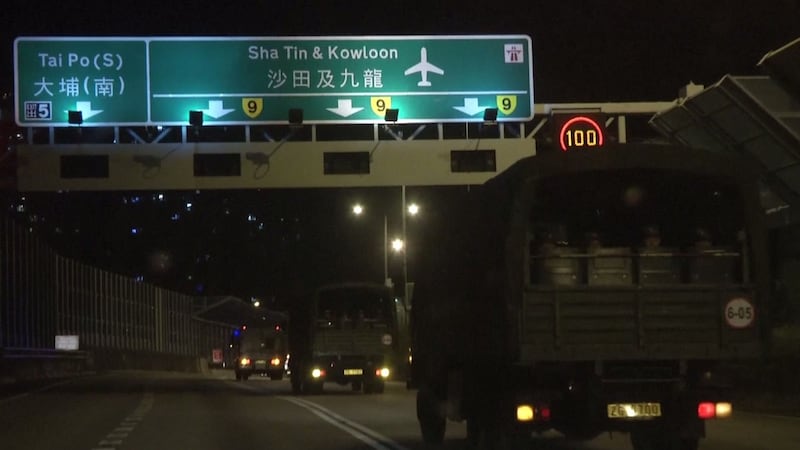China rotated troops in its People's Liberation Army (PLA) garrison in Hong Kong on Thursday, days before protesters planned to hold a march calling for full democracy for the Chinese-ruled city after three months of sometimes violent demonstrations.
Chinese state media described the troop movement in the early hours as routine and Asian and Western diplomats watching PLA movements in the former British colony had been expecting it.
But, even if routine, the timing is likely to hit nerves in the “special administrative region” of Hong Kong, which returned to China in 1997.
China’s military will make even greater contributions to maintaining Hong Kong’s prosperity and stability, state news agency Xinhua cited the (PLA) garrison in the territory as saying.
The military had completed a routine troop rotation of air, land and maritime forces, the news agency said. Xinhua and the People’s Daily released pictures and footage of armoured personnel carriers moving in convoy in Hong Kong before dawn, their lights flashing.
Observers estimate the Hong Kong garrison numbers between 8,000 and 10,000 troops split between bases in southern China and a network of former British army barracks in Hong Kong.
Trucks full of white-gloved PLA soldiers rolled into Hong Kong within hours of the 1997 handover, raising questions about their role. They stage frequent drills but have seldom since been seen outside their bases.

Reuters witnesses on Thursday saw significantly more activity in and around the PLA’s Shek Kong military base in the rural New Territories than has been apparent in recent months.
China has denounced the protests and accused the United States and Britain of interfering in its affairs in Hong Kong. It has sent clear warnings that forceful intervention is possible.
Hundreds of People's Armed Police this month conducted exercises at a sports stadium in Shenzhen that borders Hong Kong a day after the US State Department said it was "deeply concerned" about their movements.
‘In line with the law’
Xinhua said the Thursday rotation was normal.
“The Hong Kong Garrison of the Chinese People’s Liberation Army conducted the 22nd rotation of its members in the wee hours of Thursday since it began garrisoning Hong Kong in 1997,” the news agency said.
“Approved by the Central Military Commission, the move is normal routine annual rotation in line with the Law of the People’s Republic of China on Garrisoning the Hong Kong Special Administrative Region, which stipulates that ‘the Hong Kong Garrison shall practise a system of rotation of its members’.”
The Chinese statement last year said the number of soldiers and amount of equipment of the troops stationed in Hong Kong “was maintained with no change”.
That was not in Thursday’s announcement.
The Civil Human Rights Front, the organiser of previous mass protests in Hong Kong that they said attracted up to two million people, plans a rally from Hong Kong’s Central business district to Beijing’s main representative Liaison Office in the city on Saturday.
The group's leader, Jimmy Sham, was attacked by two men armed with a knife and a baseball bat on Thursday, it said on its Facebook page. He was not hurt but a friend who stepped in to protect him suffered injuries to his left arm and was taken to hospital.
Protesters targeted the Liaison Office, a potent symbol of Beijing’s rule, in July, daubing anti-China slogans on its walls and signs.
Police refused permission for the march on Thursday, but the group said it would appeal.
The protest would mark five years since Beijing ruled out universal suffrage for Hong Kong and comes as Hong Kong faces its first recession in a decade, with all its pillars of growth under stress.
Unrest escalated in mid-June over a now-suspended extradition Bill that would have allowed people to be sent to mainland China for trial in Communist Party-controlled courts.
It has since evolved into calls for greater democracy under the “one country, two systems” formula under which Hong Kong has been run since 1997, guaranteeing freedoms not enjoyed on the mainland that include an independent judiciary.
The protests have posed the biggest challenge for Communist Party rulers in Beijing since president Xi Jinping took power in 2012.
Beijing is eager to quell the unrest before the 70th anniversary of the founding of the People’s Republic of China on October 1st, when Mr Xi will oversee a large military parade in the Chinese capital.
China also rotated troops in neighbouring Macau, a former Portuguese colony that returned to Chinese rule in 1999.–Reuters














